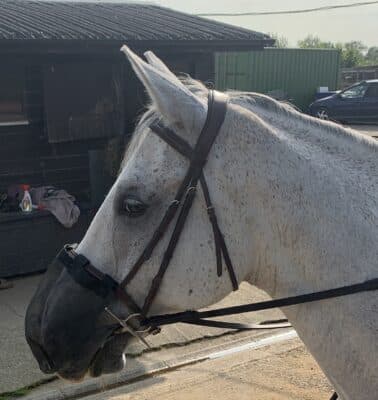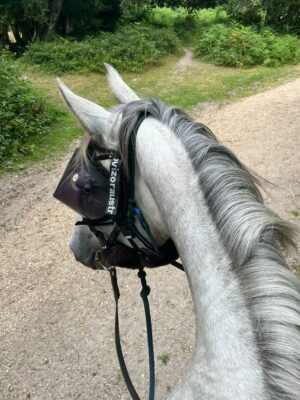Behaviour, Diseases & Conditions, Featured, Immune System
Headshaking in horses
Rebecca Watson MSc RVN, looks at the possible causes of headshaking in horses
Headshaking in horses is a condition characterised by repetitive, involuntary, and often violent shaking or jerking of the head. It can manifest as head tossing, nodding, tilting, or other similar movements. While allergies can be a potential cause of headshaking in horses, it is considered one of the less common causes, several other factors can contribute to this condition, including:
- Sensitivity to light: known as ‘photic headshaking’, and is believed to be related to nerve sensitivity in the face and muzzle.
- Neurological issues: such as trigeminal-mediated headshaking, which is believed to be caused by a dysfunction of the trigeminal nerve, a cranial nerve responsible for facial sensation.
- Dental problems: such as sharp points, malocclusions, or other dental abnormalities can cause discomfort in a horse’s mouth, leading to headshaking as a way to alleviate the discomfort.
- Respiratory issues: conditions such as allergies, asthma, or sinusitis may also exhibit headshaking as a result of nasal congestion or irritation.
- Behavioural or psychological factors: response to stress, anxiety, or other psychological factors.
Research has found that headshaking in horses is most common in geldings (in 66%+ cases) aged between 9-11 years old, but it can occur at any age and in any sex of horse. There are two other primary risk factors; a horse that has gained weight and a horse that does not regularly perform aerobic exercise, for example after a lay off period.
Approximately 60% of headshakers exhibit worsening clinical symptoms in the summertime. Experts believe that while this is related to the environment in some way, as these horses are responding to an environmental stimulus, it is impossible to say what or why in every case.
Known triggers for ‘seasonal’ headshakers include bright sunlight, wind and pollen – clinical signs are exaggerated in warmer, drier weather. Pollen from plants in the spring and summer months can similarly symptoms such as sneezing, runny nose and runny or swollen eyes, hence the need to definitively diagnose the trigger stimuli, in order to choose the best treatment / management option.
Owners are encouraged to make a diary detailing when symptoms occur and when they are worst, to help their veterinary surgeon come to a diagnosis.
When it comes to treating headshakers, it is generally recommended to start with a single treatment and continue long enough to know if the treatment has effect.

Nose nets
In many cases a common trigger centres around some form of nasal stimulation, this is where nose nets and face masks can be useful. It was initially believed that a nose net or face mask altered the airflow pattern, temperature of the air or particle content meeting the nasal passages and, helped to alleviate symptoms. However, experts now believe that they work by constantly stimulating sensory nerve endings in the nose, which can suppress the overactive nerves that are sending sharp pain signals to the brain. This reduces the painful sensation rather like rubbing part of your body after you hurt it. Nose nets or face masks lead to a 25% improvement in approximately 75% of cases, so if you have a mild headshaker this could be your first port of call.
Eye sensitivity
Horses with eye sensitivity may not necessarily be affected by pollen and other allergens, but they are by light. These ‘photic’ headshakers may seek shade and show relief when kept out of the sun. Affected horses may also flip their head in reaction to wind, movement and exercise. Extreme nose blowing, snorting and coughing are other symptoms of photic headshaking, which can appear to present as an allergic response.
Photic headshaking is believed to cause a burning sensation or tingling of the muzzle (neuropathic pain) in response to bright sunlight. The mechanism may be similar to photic sneezing in humans, in which staring into sunlight triggers sneezing episodes. Photic sneezing in humans is a heritable, non-allergic disorder. If photic headshaking is thought to be a problem, using a 90% UV blocking mask and stabling the horse during the day, with night-time turnout can be a beneficial management strategy.

Many headshakers are more sensitive to insects than usual, so implementing effective fly repellent is important during the warmer spring and summer months.
Magnesium is an electrolyte that can have a calming effect and may help support normal functioning of the trigeminal nerve. Supplementation with higher-than-normal doses may be advantageous but should only be done under veterinary care and supervision.
Melatonin may help adjust the circadian rhythm for these seasonally affected headshaking horses and alleviate symptoms.
Medical treatments that may be recommended by your veterinary surgeon include cyproheptadine, an antihistamine, dexamethasone, a corticosteroid, and carbamazepine, an anti-seizure medication for humans.
Headshaking is a condition that is often managed rather than cured and has been known to be progressive in some cases. Unfortunately, in up to 50% of cases, it is not possible to find an effective treatment or management protocol. If a horse has severe, or persistent head shaking and clinical symptoms are deteriorating in spite of treatment, it is important to remember, welfare of the horse is paramount.
